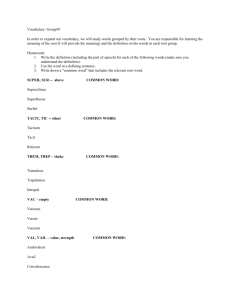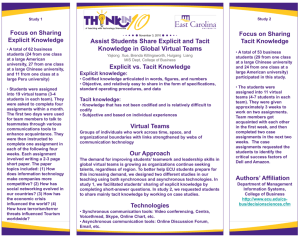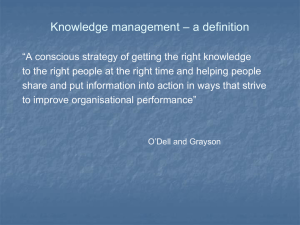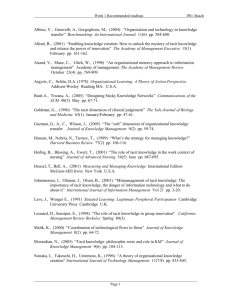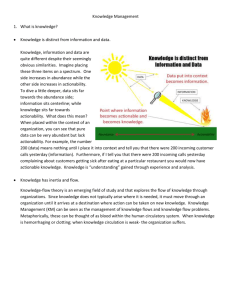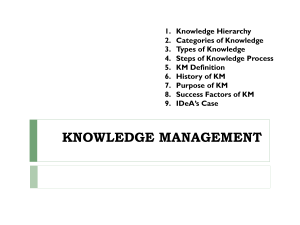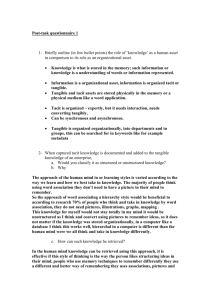The Application of Social Software in Construction and Management
advertisement
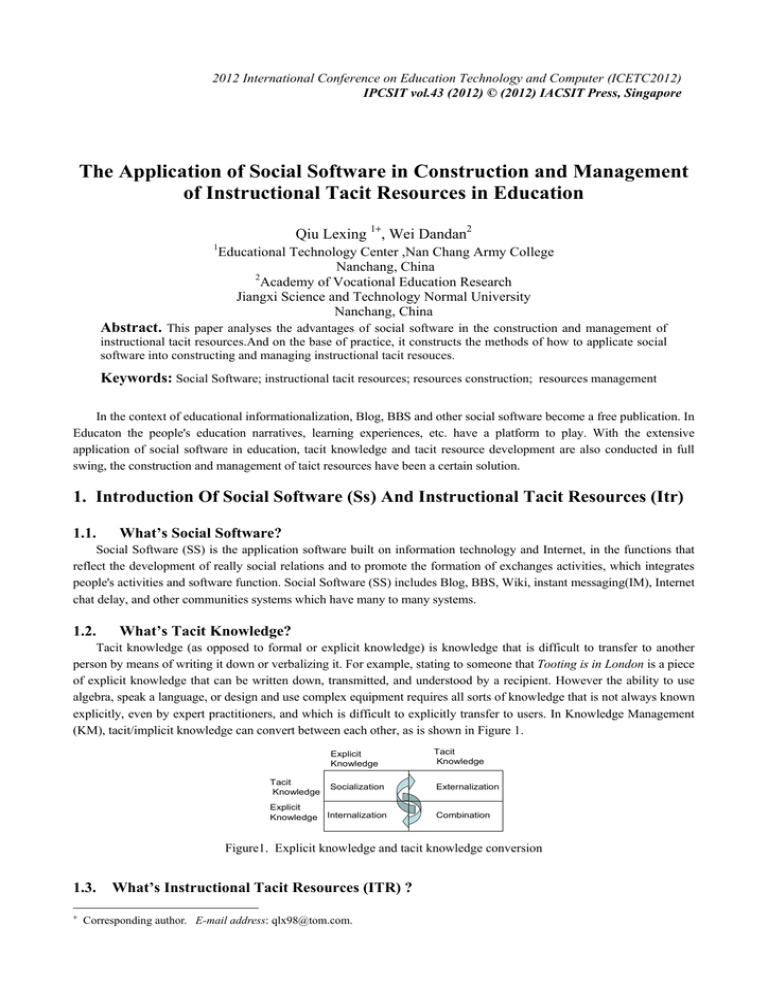
2012 International Conference on Education Technology and Computer (ICETC2012) IPCSIT vol.43 (2012) © (2012) IACSIT Press, Singapore The Application of Social Software in Construction and Management of Instructional Tacit Resources in Education Qiu Lexing 1+, Wei Dandan2 1 Educational Technology Center ,Nan Chang Army College Nanchang, China 2 Academy of Vocational Education Research Jiangxi Science and Technology Normal University Nanchang, China Abstract. This paper analyses the advantages of social software in the construction and management of instructional tacit resources.And on the base of practice, it constructs the methods of how to applicate social software into constructing and managing instructional tacit resouces. Keywords: Social Software; instructional tacit resources; resources construction; resources management In the context of educational informationalization, Blog, BBS and other social software become a free publication. In Educaton the people's education narratives, learning experiences, etc. have a platform to play. With the extensive application of social software in education, tacit knowledge and tacit resource development are also conducted in full swing, the construction and management of taict resources have been a certain solution. 1. Introduction Of Social Software (Ss) And Instructional Tacit Resources (Itr) 1.1. What’s Social Software? Social Software (SS) is the application software built on information technology and Internet, in the functions that reflect the development of really social relations and to promote the formation of exchanges activities, which integrates people's activities and software function. Social Software (SS) includes Blog, BBS, Wiki, instant messaging(IM), Internet chat delay, and other communities systems which have many to many systems. 1.2. What’s Tacit Knowledge? Tacit knowledge (as opposed to formal or explicit knowledge) is knowledge that is difficult to transfer to another person by means of writing it down or verbalizing it. For example, stating to someone that Tooting is in London is a piece of explicit knowledge that can be written down, transmitted, and understood by a recipient. However the ability to use algebra, speak a language, or design and use complex equipment requires all sorts of knowledge that is not always known explicitly, even by expert practitioners, and which is difficult to explicitly transfer to users. In Knowledge Management (KM), tacit/implicit knowledge can convert between each other, as is shown in Figure 1. Explicit Knowledge Tacit Knowledge Tacit Knowledge Socialization Externalization Explicit Knowledge Internalization Combination Figure1. Explicit knowledge and tacit knowledge conversion 1.3. + What’s Instructional Tacit Resources (ITR) ? Corresponding author. E-mail address: qlx98@tom.com. From the perspective of resource morphology, resource has the distinctions of dynamic, static and explicit, implicit/tacit. With the change of knowledge view, tacit knowledge, hidden curriculum are highly concerned in Education, therefore, in teaching tacit resources become an extremely valuable fortune. Implicit, dynamic resource is related to human resources, environmental resources. Therefore, the so-called instructional tacit resources, can be defined as the knowledge that an individual or group / team have gain in a certain situation during teaching or learning, including teaching or learning experience, insight, advice, idea, opinon and so on [1]. 2. The Advantages Of Social Software (Ss) In The Construction And Management Of Instructional Tacit Resources (Itr) 2.1. Allowing ITR to Keep Pace with the Times Social Software can be used for teaching reflection, education narrative of teachers. Students can take it (Blog or BBS) as their e-learning portfolio to record their own learning throughout process and the progress of various stages. With the development of the teaching and learning activities, tacit resources have also become increasingly rich, perfect, value-added to form a high-effective resource repository [2]. 2.2. Promoting the Development of Personalized ITR Social software take the Internet as its carrier, which decide its shared and open nature, and also determines its strong interactivity. Through social software, students and teachers can express their knowledge and insights, share others ideas and resources. And further, they sharing and communication to generate new knowledge in groups. And also through other people's comments assessment ,they can promote their own updates and development of instructional tacit resources, to create a personalized instructional tacit resource repository [3]. 2.3. Realizing the Category, Archive, Rational Organization, Fast Retrieval of ITR Social software itself (Blog or BBS) has the features of a hypertext link, network interaction, dynamic update, autoarchiving, etc [4]. which easily realize the category, archive, fast retrieval of ITR. 2.4. Compositing a Small Individual and Organizational Knowledge Management System After learners complete a related course, the knowledge acquired in their mind has formed implicit knowledge. Through the Blog and BBS forum, teachers and students communicate in online, to be the exchange of knowledge. And also through "reflection", the knowledge of teachers and students will continue to do externalization and internalization conversion, to form a rich tacit resource base, which achieve the implicit - explicit knowledge conversion between personal and organization (group) [5][6]. The relation has shown in Figure 1. However, a successful KM system needs to achieve rapid and accurate retrieval in the knowledge base. Social Software (Blog, BBS & etc) can use knowledge management theory to manage a variety of knowledge, which provides knowledge retrieval a convenient condition on the future. These have been confirmed by researchers. 3. The Methods Of Social Software (Ss) In The Construction Of Instructional Tacit Resources (Itr) The research of this paper is based on two commonly used Blog and BBS social software, which composite the instructional tacit resources platform. The platform combines the two characteristics of Blog and BBS. Based on social software (Blog and BBS), the system framework of ITR construction and management is shown in Figure 2. Figure 2 shows the system framework of instructional tacit resources construction and management supported by social software (Blog and BBS). The construction of the tacit resources mainly reflected in two aspects: resource publication and post comment. The following are the definite methods of ITR construction. 3.1. Teachers and Students Participate in Resource Development All Together Teachers and students are no longer the consumers of resources, but the builders of resources. In the practical teaching applications, teachers need to lead the students as the main resource constructors. 3.2. Integrate Corresponding Courses of Study into Social Software Platform According to the corresponding courses, learners can freely express personal experiences, learning experiences and other personal tacit knowledge. Study groups can also express the process accumulation of the completed task by the team. Teachers can be raised for discussion here, questions or assigning tasks, and to aim at an issue or task, learners are able to express different views and opinions. As the saying goes "Reading history can be wise", post-learners of courses through this platform who see the wisdom resources of the corresponding curriculum, can again, thus further build their own tacit resources. Construct Manage Tacit Resources Repository Teacher Use Feedback Guide Experiences Good Methods Student A B C …… Construct Manage Puzzles and Settlements Good Advices …… Use The Instructional Tacit Resources Platform Composed of Social Software ( Blog and BBS ) Tacit Resources Construction Resources Release Post Comment Tacit Resources Management Resources Category Resources Archive Resources Retrieve Site Statistic Essence Resources Latest Comment Figure 2. The system framework of ITR construction and management surported by social software (Blog and BBS) 3.3. Require Teachers and Students to Long-term and Regularly Use Social Software Platform In teaching practice, we require teachers and students to long-term and regularly write blogs, including education narrative, learning experience and so on. After class they can discussion based on this platform for exchange of teaching or learning problem. For the individual student, from admission to graduation he or she will feel fruits at this stage, rather than feeling nothing to learn. On the whole, different professions, different grades and different courses, there are corresponding tacit resources. Content managers organize these resources into a book regularly to ultimately form an abundant repository of tacit resources, which will be made for the professional development of teachers and students. 4. The Methods of SOCIAL SOFTWARE (SS) IN THE MANAGEMENT OF INSTRUCTIONAL TACIT RESOURCES (itr) based on social software 4.1. Manage and Maintenance Background Based on Social Software As the Figure 2 is shown, the implicit resources platform mainly provides two plates, including the resource community (Blog) and the forum community (BBS) two plates. The following are the definite methods of ITR management. 1) Resource community. Resource community makes the best of the character of Web hypertext, which publish excellent resources on the network platform. Through the active participation of members and the careful finishing of administrator, it is suitable for learners to conduct after-school learning and summed up, to provide a self-learning environment and conditions for learners, and to make up for the lack of teaching in classroom, allow students to more easily share the abundant network resources. In order to more convenient services for teachers and learners, based on implicit social software, teaching resource management, we must firstly plan the elements and structure on the social software. And then, we go into the social software management background in accordance with the planning, undertake the following tasks: a)Establishment resource classification. To manage instructional tacit resources of the subject, we divide them in accordance with the composition of the teaching tacit resources, namely published resources and learning experiences etc by teachers and students for according to professional categories, which are their expertise summarized or network sharing of learning materials by learners. So learners can promote learning from each other. In addition, all of the resources are categorize on the platform by profession, which can effectively prevent the messy situation for increasingly rich resource of resources, while learners can fast and easily find the necessary resources to save search time. Such as: we implement the construction and management of instructional tacit resources in Educational Technology in University based on this platform. We go into the background management to classify resources, according to pedagogical needs, which divided into imaging optics and color science, POTOSHOP learning, two-dimensional three-dimensional animation, photography camera and so on, when learners click on any of them, they can search for the corresponding implicit resources. Such as clicking learning experience, there will be learning experience for all of the resources. b) Do with Archiving of Resources. Conduct site statistics: its function is to statistics the number of entries of all resources, comments, references, visitor comments, registered members as well as traffic to your pages and so on. Through these statistics, we can quickly understand for the development status and scale of the platform, which also help the administrators to keep abreast of platform development trends, to provide the future development of the platform for reference observations. Recommend essential resources: the essence of the so-called resource is more respected, or learnerlearner who believe quite representative resources, which are vetted, approved and set essence tab by the super administrator, which is an aspect of promoting effective management of resources. Show the latest comments: Recent Comments is the latest some of the comment information by teacher or learner on the platform resources. In addition, all of resources are classified by month, which is also an optimized way for resource management. The ultimate goal makes users to Quick Search Resources. c) Formation Resources Search. Resources search is to provide the internal site search engine, which can choose to search internal resources by title or content, as the ultimate goal is to quickly locate the resources you want to find. 2) Community Forum. Community forum provides an online communication function to facilitate teacher-student collaboration and discussion. Through the online discussion learners can explore ideas, enhance learning motivation, inspire passion for learning, reinforce strengthen teacher-student, studentstudent links. Through the analysis of the exchange records teachers can understand and master students’ thinking and learning dynamics, and can use targeted teaching strategies. Discussion forum will be required in the classroom on teaching and learning activities transferred to outside the classroom, which can save teaching time, effectively expand teachers teaching time and space. The system can be freely registered by any member. You can click "registered" on the upper right corner, and then enter the registration interface. After successful register, the system will present you original score (10 points), and then automatically log on to the login screen, you can carry out post and response. Registered members can enjoy the winning points on Posts (this site 2 points by a post, 1 point by a reply), the user system automatically record your score. With the development of teaching and learning activities, the system can quickly analyze the frequency of using the forum community for learners, in order to monitor the learning process of learners. 4.2. Do Well with Content Management Based on Social Software Ask administrator to monitor the content, and focus on the validity of the content, delete spam. 4.3. Set Out Management Mechanism Select an administrator in every course, and ask them to manage resources regularly. 5. Conclusion This paper is based on knowledge management (KM) theory, construction and management of instructional recessive resources is based on two commonly used Blog and BBS social software, which composit the instructional tacit resources platform. Practice has proved that good results of this application. The platform combines the two characteristics of tacit resources and social software. It reflects the subjectivity of students, emphasizing the sharing of knowledge, attention to exploratory learning and facilitate the process of assessment proceedings and so on. These will be great significance in the teaching reforms. 6. References [1] [2] [3] [4] [5] [6] Guoxiong Xiang, and Dandan Wei, “Effective Strategies of Utilizing Human Resources in Online Learning, ” China Audio-Visual Education, Vol. 215, Dec, 2004, pp.61-63. Ren Jian, Liu Hu, “Research on The Application of Knowledge Management to Build Educational Resource Management Framework of Schools,” China Audio-Visual Education, Vol. 243, April, 2007, pp.58-59. Piedra&etc, “Open Educational Practices and Resources Based on Social Software: UTPL Experience,” Ninth IEEE International Conference on Advanced Learning Technologies(ICALT 09), July, 2009, pp.497-498.doi: 10.1109/ICALT.2009.224 . Xuhua Liu, Du Jun, “Based on Blog's Personal Knowledge Management,” Modern Educational Technology, Vol. 17, Sept, 2007, p.79. Chenling Zhao, Jianxiao Cao, Xinhua Guo, Personal knowledge management based on social software, IFIP Advances in Information and Communication Technology, Vol. 252, Integration and Innovation Orient to ESociety Volume 2, Boston: Springer, 2007, pp.346-354. doi:10.1007/978-0-387-75494-9_42. Arben Asllani&etc, “Sharing Knowledge with Conversational Technologies: Web Logs Versus Discussion Boards,” International Journal of Infomation Technology and Management . Vol.7, No.2, 2008, pp.217-230.
